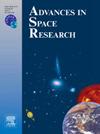用EISCAT和MAARSY研究流星头回波等离子体分布的高度依赖性
IF 2.8
3区 地球科学
Q2 ASTRONOMY & ASTROPHYSICS
引用次数: 0
摘要
在2022年双子座流星雨期间,挪威北部使用高功率大孔径(HPLA)雷达进行了一项雷达运动,以测量流星头回波。MAARSY (53.5 MHz)、EISCAT VHF (224 MHz)和EISCAT UHF (930 MHz)雷达都在天顶指向方向上工作。EISCAT VHF雷达和EISCAT UHF雷达的视场基本一致。提出了一种新的流星头回波处理算法,该算法适用于EISCAT Manda实验模式,提供了流星头回波范围、多普勒频移和信噪比等参数。确定了三种不同系统的流星头回波探测率随海拔高度的变化规律。为了研究流星头回波检出率的差异,进一步分析了EISCAT VHF和EISCAT UHF同时探测到的流星。确定了EISCAT系统之间信噪比差的高度依赖性,并将其归因于大气平均自由程的变化。该数据用于确定等离子体密度衰减率作为r - χ的函数,其中r是到流星体中心的距离。发现χ值在2至4之间(1/r2至1/r4)。当考虑相对雷达灵敏度和瑞利散射效应时,MAARSY、EISCAT VHF和EISCAT UHF系统的流星头回波探测率差异可以用等离子体密度衰减率来解释。研究结果对确定入射流星体的初始质量和消融过程中相关的质量损失率具有重要意义。本文章由计算机程序翻译,如有差异,请以英文原文为准。
Examining the altitude dependence of meteor head echo plasma distributions with EISCAT and MAARSY
A radar campaign with High Power Large Aperture (HPLA) radars in northern Norway was performed for the Geminids 2022 meteor shower to make measurements of meteor head echoes. The MAARSY (53.5 MHz), EISCAT VHF (224 MHz), and EISCAT UHF (930 MHz) radars were all operated in a zenith pointing direction. The field-of-views for the EISCAT VHF and EISCAT UHF radars were approximately coincident. A novel meteor head echo processing algorithm was implemented for the EISCAT Manda experiment mode, providing details on the meteor head echo range, Doppler shift, and signal-to-noise ratio (SNR). The occurrence rate of meteor head echo detections for the three different systems were determined as a function of altitude. To investigate the differences in the meteor head echo detection rates, simultaneously detected meteors from the EISCAT VHF and EISCAT UHF were further examined. An altitude dependence of SNR difference between the EISCAT systems was identified and attributed to changes in the atmospheric mean free path. This data was used to determine a plasma density decay rate as a function of r−χ, where r is the distance from the center of the meteoroid. was found to have a value of between 2 to 4 (1/r2 to 1/r4). The meteor head echo detection rate differences between MAARSY, EISCAT VHF, and EISCAT UHF systems can be explained using this plasma density decay rate when the relative radar sensitivities and Rayleigh scattering effects are considered. The results have important implications for the determination of the initial mass of incoming meteoroids and the associated mass-loss rates during ablation.
求助全文
通过发布文献求助,成功后即可免费获取论文全文。
去求助
来源期刊

Advances in Space Research
地学天文-地球科学综合
CiteScore
5.20
自引率
11.50%
发文量
800
审稿时长
5.8 months
期刊介绍:
The COSPAR publication Advances in Space Research (ASR) is an open journal covering all areas of space research including: space studies of the Earth''s surface, meteorology, climate, the Earth-Moon system, planets and small bodies of the solar system, upper atmospheres, ionospheres and magnetospheres of the Earth and planets including reference atmospheres, space plasmas in the solar system, astrophysics from space, materials sciences in space, fundamental physics in space, space debris, space weather, Earth observations of space phenomena, etc.
NB: Please note that manuscripts related to life sciences as related to space are no more accepted for submission to Advances in Space Research. Such manuscripts should now be submitted to the new COSPAR Journal Life Sciences in Space Research (LSSR).
All submissions are reviewed by two scientists in the field. COSPAR is an interdisciplinary scientific organization concerned with the progress of space research on an international scale. Operating under the rules of ICSU, COSPAR ignores political considerations and considers all questions solely from the scientific viewpoint.
 求助内容:
求助内容: 应助结果提醒方式:
应助结果提醒方式:


